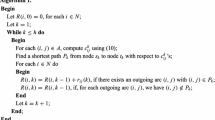Abstract
A power assignment is an assignment of transmission power to each of the nodes of a wireless network, so that the induced communication graph has some desired properties. The cost of a power assignment is the sum of the powers. The energy of a transmission path from node u to node v is the sum of the squares of the distances between adjacent nodes along the path. For a constant t > 1, an energy t-spanner is a graph G′, such that for any two nodes u and v, there exists a path from u to v in G′, whose energy is at most t times the energy of a minimum-energy path from u to v in the complete Euclidean graph. In this paper, we study the problem of finding a power assignment, such that (1) its induced communication graph is a ‘good’ energy spanner, and (2) its cost is ‘low’. We show that for any constant t > 1, one can find a power assignment, such that its induced communication graph is an energy t-spanner, and its cost is bounded by some constant times the cost of an optimal power assignment (where the sole requirement is strong connectivity of the induced communication graph). This is a significant improvement over the previous result due to Shpungin and Segal in Proceedings of 28th IEEE INFOCOM, pp 163–171, (2009).

Similar content being viewed by others
References
Althöfer, I., Das, G., Dobkin, D., Joseph, D., & Soares, J. (1993). On sparse spanners of weighted graphs. Discrete and Computational Geometry, 9(1), 81–100.
Bose, P., & Morin, P. (2004). Competitive online routing in geometric graphs. Theoretical Computer Science, 324(2–3), 273–288.
Bose, P., & Morin, P. (2004). Online routing in triangulations. SIAM Journal on Computing, 33(4), 937–951.
Chandra, B., Das, G., Narasimhan, G., & Soares, J. (1995). New sparseness results on graph spanners. International Journal of Computational Geometry and Applications, 5, 125–144.
Chen, W.-T., & Huang, N.-F. (1989). The strongly connecting problem on multihop packet radio networks. IEEE Transactions on Communications, 37(3), 293–295.
Clementi, A. E. F., Penna, P., & Silvestri, R. (1999). Hardness results for the power range assignmet problem in packet radio networks. In Proceedings of the third international workshop on approximation algorithms for combinatorial optimization problems (RANDOM-APPROX’99) (pp. 197–208). London, UK: Springer.
Das, G., & Narasimhan, G. (1997). A fast algorithm for constructing sparse Euclidean spanners. International Journal of Computational Geometry and Applications, 7(4), 297–315.
Das, G., Narasimhan, G., & Salowe, J. S. (1995) A new way to weight malnourished Euclidean graphs. In Proceedings of the 6th annual ACM-SIAM symposium on discrete algorithms (pp. 215–222).
de Berg, M., Cheong, O., Kreveld, M., & Overmars, M. (2008). Computational geometry: Algorithms and applications. London: Springer.
Estrin, D., Govindan, R., Heidemann, J., Kumar, S. (1999). Next century challenges: Scalable coordination in sensor networks. In Proceedings of the ACM/IEEE international conference on mobile computing and networking (MOBICOM 1999) (pp. 263–270). Seattle, Washington, USA.
Hubaux, J.-P., Gross, T., Boudec, J.-Y.-L., & Vetterli, M. (2001). Towards self-organized mobile ad hoc networks: The terminodes project. IEEE Communications Magazine, 39(1), 118–124.
Kirousis, L., Kranakis, E., Krizanc, D., & Pelc, A. (2000). Power consumption in packet radio networks. Theoretical Computer Science, 243(1–2), 289–305.
Li, X.-Y., Wan, P.-J., & Wang, Y. (2001). Power efficient and sparse spanner for wireless ad hoc networks. In Proceddings 10th international conference computer communications and networks (pp. 564–567).
Pahlavan, K., & Levesque, A. H. (1995). Wireless information networks. New Jersey: Wiley-Interscience.
Pottie, G. J., & Kaiser, W. J. (2000). Wireless integrated network sensors. Communication of the ACM, 43(5), 51–58.
Rabaey, J., Ammer, M., da Silva, Jr. J., Patel D., & Roundy, S. (2000). Picoradio supports ad hoc ultra-low power wireless networking. IEEE Computer Magazine, 33(7), 42–48.
Rappaport, T. (1996). Wireless communications: Principles and practice. Prentice-Hall, Englewood Cliffs, NY.
Shpungin, H., & Segal, M. (2009). Near optimal multicriteria spanner constructions in wireless ad-hoc networks. In Proceedings of the 28th IEEE International Conference on Computer Communications (INFOCOM 2009) (pp. 163–171).
Wang, Y., & Li, X.-Y. (2006). Minimum power assignment in wireless ad hoc networks with spanner property. Journal of Combinatorial Optimization, 11(1), 99–112.
Author information
Authors and Affiliations
Corresponding author
Additional information
A preliminary version of this paper appears in Proceedings of the 29th IEEE International Conference on Computer Communications, 2010.
Rights and permissions
About this article
Cite this article
Abu-Affash, A.K., Aschner, R., Carmi, P. et al. Minimum power energy spanners in wireless ad hoc networks. Wireless Netw 17, 1251–1258 (2011). https://doi.org/10.1007/s11276-011-0346-7
Published:
Issue Date:
DOI: https://doi.org/10.1007/s11276-011-0346-7




